
We took a couple of days of for a family vacation / road trip through
the hills of Central Mexico. The overall trip does not look like
anything out of the ordinary
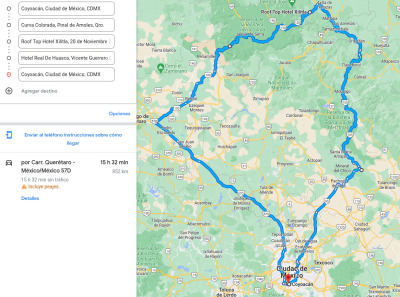
Other than the fact that Google forecasted we d take approximately
15.5 hours driving for 852Km that is, an average of almost 55
Km/h. And yes, that s what we signed up for. And that s what we
got. Of course, the exact routes are not exactly what Google suggested
(I can say we optimized a bit the route, i.e., by avoiding the
metropolitan area of Quer taro, at the extreme west, and going via San
Juan del R o / Tequisquiapan / Bernal).
The first stretch of the road is just a regular, huge highway, with
no particular insights. The highways leaving and entering Mexico City
on the North are not fun nor beautiful, only they are needed to get
nice trips going
Mexico City sits at a point of changing climates. Of course, it is a
huge city And I cannot imagine how it would be without all of the
urbanization it now sports. But anyway: On the West, South, and part
of the East, it is surrounded by high mountains, with beautiful and
dense forests. Mexico City is 2200m high, and most of the valley s
surrounding peaks are ~3000m (and at the South Eastern tip, our two
big volcanoes, Popocat petl and Iztacc huatl, get past the 5700m
mark). Towards the North, the landscape is flatter and much more
dry. Industrial compounds give way to dry grasslands. Of course,
central Mexico does not understand the true meaning of
flat, and the
landscape is full with eh-not-very-big mountains.
Then, as we entered Quer taro State, we started approaching
Bernal. And we saw a huge rock that looks like it is not supposed
to be there! It just does not fit the surroundings.

Shortly after Bernal, we entered a beautiful, although most crumpled,
mountain ridge:
Sierra Gorda de
Quer taro. Sierra Gorda
encompasses most of the North of the (quite small 11500Km total)
state of Quer taro, plus portions of the neighboring states; other
than the very abrupt and sharp orography, what strikes me most is the
habitat diversity it encompasses. We started going up an absolute
desert, harsh and beautiful; we didn t take pictures along the way as
the road is difficult enough that there are almost no points for
stopping for refreshments or for photo opportunities. But it is quite
majestic. And if you think deserts are barren, boring places well,
please do spend some time enjoying them!
Anyway At on point, the road passes by a ~3100m height, and
suddenly Pines! More pines! A beautiful forest! We reached our
first stop at the originally mining town of
Pinal de
Amoles.
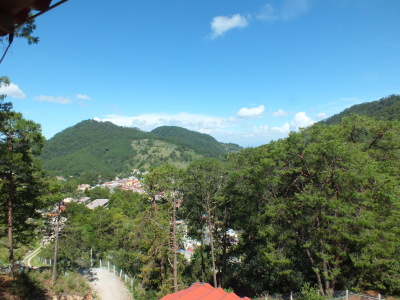



After spending the night there and getting a much needed rest, we
started a quite steep descent towards
Jalpan de
Serra. While it is
only ~20Km away on the map, we descended from 2300 to 760 meters of
altitude (and the road was over 40Km long).

Being much lower, the climate drastically changed from cool and humid
to quite warm and the body attitude in the kids does not lie!

In the mid-18th century, Fray Jun pero Serra established five missions
to evangelize the population of this very harsh territory, and the
frontispiece for the church and monastery in Jalpan is quite
breathtaking.





But we were just passing by Jalpan. A short visit to the church and to
the ice-cream shop, and we were again on our way. We crossed the state
border, entering San Luis Potos , and arrived to our main destination:
Xilitla, the little town in
the beautiful
Huasteca where
the jungle meets surrealism.
Xilitla was chosen by the British poet and patron of various
surrealist artists
https://en.wikipedia.org/wiki/Edward_James. He was a British noble (an
unofficial grandson of King
Edward VII), and heir to a huge fortune. I m not going to repeat here
his very well known biography suffice to say that he got in love
with the Huasteca, and bought a >30ha piece of jungle and mountain
close to the Xilitla town, and made it his house. With very ample
economic resources, in the late 1940s he started his lifelong project
of building a surrealist garden.
And Well, that s enough blabbering for me. I m sharing some
pictures I took there. The place is plainly magic and
wonderful. Edward James died in 1984, and his will decrees that after
his death, the jungle should be allowed to reclaim the constructions
so many structures are somewhat crumbling, and it is expected they
will break down in the following decades. But for whoever comes to
Mexico This magic place is definitely worth the heavy ride to the
middle of the mountains and to the middle of the jungle.




















Xilitla now also hosts a very good museum with sculptures by Leonora
Carrington, James long-time friend, but I m not going to abuse this
space with even more pictures. And of course, we did more, and enjoyed
more, during our three days in Xilitla.
And for our way back I wanted to try a different route. We decided
to come back to Mexico City crossing Hidalgo state instead of
Quer taro. I had feared the roads would be in a worse shape or would
be more difficult to travel And I was happy to be proven wrong!

This was the longest driving stretch approximately 6:30 for
250Km. The roads are in quite decent shape, and while there are some
stretches where we were quite lonely (probably the loneliest one was
the sharp ascent from Tamazunchale to the detour before Orizatl n),
the road felt safe and well kept at all times. The sights all across
Eastern Hidalgo are breathtaking, and all furiously green (be it with
really huge fern leaves or with tall, strong pines), until
Zacualtip n.

And just as abruptly or more as when we entered Pinal de Amoles We
crossed Orizatl n, and we were in a breathtaking arid, desert-like
environment again. We crossed the
Barranca de Metztitl n natural
reserve, and arrived to spend the night at Huasca de Ocampo.
There are many more things we could have done starting at Huasca, a
region where old
haciendas thrived, full of natural formations, and
very very interesting. But we were tired and pining to be finally back
home. So we rested until mid-morning and left straight back home in
Mexico City. Three hours later, we were relaxing, preparing lunch, the
kids watching whatever-TV-like-things are called nowadays.
All in all, a very beautiful vacation!

 A real sad state of affairs
A real sad state of affairs 

 We took a couple of days of for a family vacation / road trip through
the hills of Central Mexico. The overall trip does not look like
anything out of the ordinary
We took a couple of days of for a family vacation / road trip through
the hills of Central Mexico. The overall trip does not look like
anything out of the ordinary



































 This post describes how to deploy
This post describes how to deploy 

 From May 25th to 27th, Bras lia hosted the
From May 25th to 27th, Bras lia hosted the
 Activities
The MiniDebConf program was intense and diverse. On May 25th and 26th (Thursday
and Friday), we had talks, discussions, workshops, and many hands-on activities.
On the 27th (Saturday), the Hacking Day took place, which was a special moment
for Debian contributors to come together and work collaboratively on various
aspects of the project. This was the Brazilian version of Debcamp, a tradition
preceding DebConf. On this day, we prioritized practical activities such as
software packaging, translations, key signing, install fest, and the Bug
Squashing Party.
Activities
The MiniDebConf program was intense and diverse. On May 25th and 26th (Thursday
and Friday), we had talks, discussions, workshops, and many hands-on activities.
On the 27th (Saturday), the Hacking Day took place, which was a special moment
for Debian contributors to come together and work collaboratively on various
aspects of the project. This was the Brazilian version of Debcamp, a tradition
preceding DebConf. On this day, we prioritized practical activities such as
software packaging, translations, key signing, install fest, and the Bug
Squashing Party.
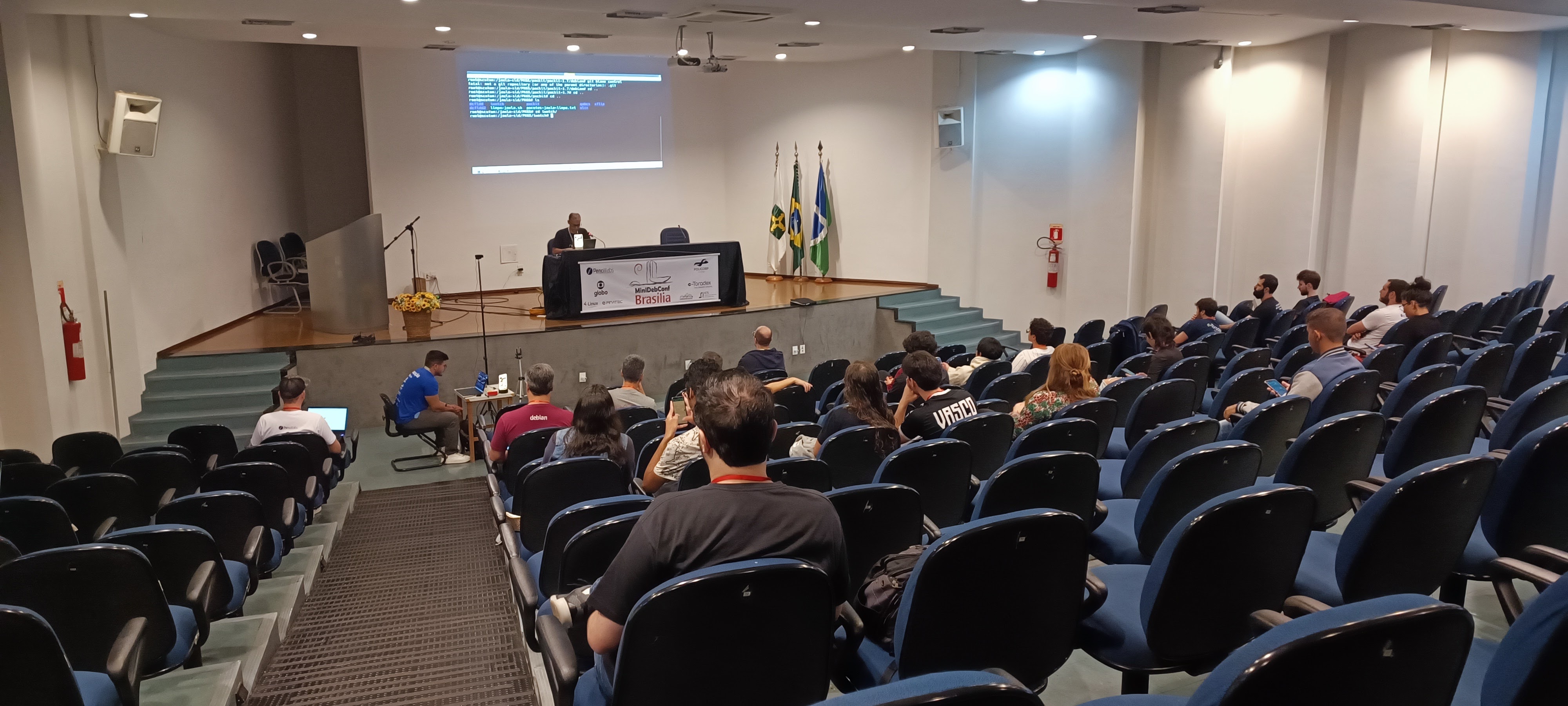
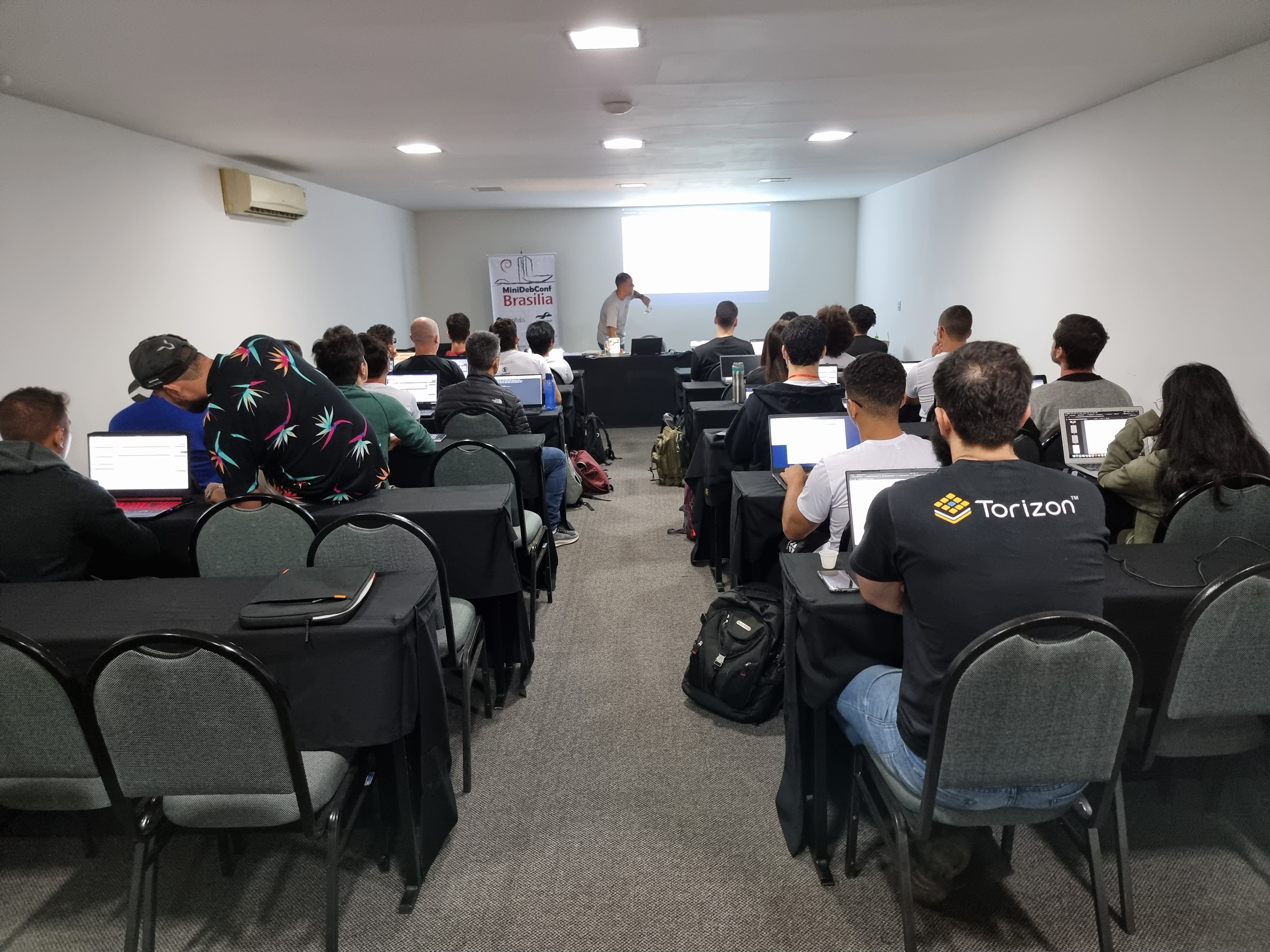 Edition numbers
The event numbers are impressive and demonstrate the community's involvement
with Debian. We had 236 registered participants, 20 submitted talks, 14
volunteers, and 125 check-ins. Furthermore, in the hands-on activities, we
achieved significant results, including 7 new installations of Debian GNU/Linux,
the update of 18 packages in the official Debian project repository by
participants, and the inclusion of 7 new contributors to the translation team.
We also highlight the remote participation of the community through live
streams. The analytics data reveals that our website received a total of 7,058
views, with 2,079 views on the homepage (which featured our sponsors' logos),
3,042 views on the program page, and 104 views on the sponsors' page. We
recorded 922 unique users during the event.
On YouTube, the live stream reached 311 views, with 56 likes and a peak of 20
concurrent views. There were an incredible 85.1 hours of watch time, and our
channel gained 30 new subscribers. All this engagement and interest from the
community further strengthen MiniDebConf.
Edition numbers
The event numbers are impressive and demonstrate the community's involvement
with Debian. We had 236 registered participants, 20 submitted talks, 14
volunteers, and 125 check-ins. Furthermore, in the hands-on activities, we
achieved significant results, including 7 new installations of Debian GNU/Linux,
the update of 18 packages in the official Debian project repository by
participants, and the inclusion of 7 new contributors to the translation team.
We also highlight the remote participation of the community through live
streams. The analytics data reveals that our website received a total of 7,058
views, with 2,079 views on the homepage (which featured our sponsors' logos),
3,042 views on the program page, and 104 views on the sponsors' page. We
recorded 922 unique users during the event.
On YouTube, the live stream reached 311 views, with 56 likes and a peak of 20
concurrent views. There were an incredible 85.1 hours of watch time, and our
channel gained 30 new subscribers. All this engagement and interest from the
community further strengthen MiniDebConf.
 Photos and videos
To relive the best moments of the event, we have photos and recordings
available. Photos can be accessed at: https://deb.li/pbsb2023. Video recordings
of the talks are available at the following link:
Photos and videos
To relive the best moments of the event, we have photos and recordings
available. Photos can be accessed at: https://deb.li/pbsb2023. Video recordings
of the talks are available at the following link:  MiniDebConf Bras lia 2023 was a milestone for the Debian community,
demonstrating the power of collaboration and Free Software. We hope that
everyone enjoyed this enriching gathering and will continue to actively
participate in future Debian Project initiatives. Together, we can make a
difference!
MiniDebConf Bras lia 2023 was a milestone for the Debian community,
demonstrating the power of collaboration and Free Software. We hope that
everyone enjoyed this enriching gathering and will continue to actively
participate in future Debian Project initiatives. Together, we can make a
difference!
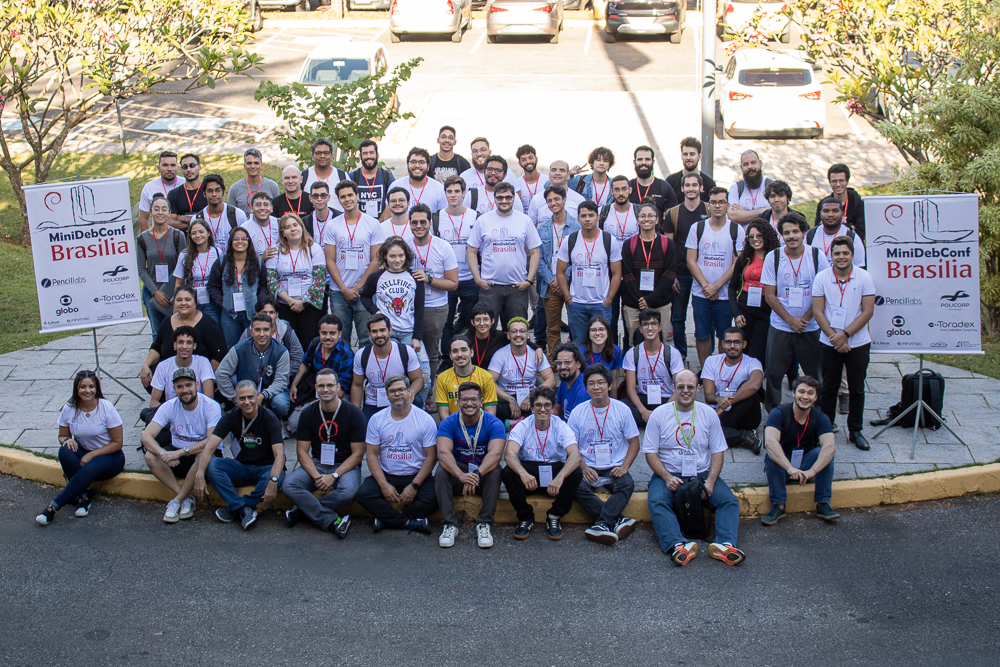
 Hello folks!
We recently received a case letting us know that Dataproc 2.1.1 was unable to write to a BigQuery table with a column of type JSON. Although the BigQuery connector for Spark has had support for JSON columns since 0.28.0, the Dataproc images on the 2.1 line still cannot create tables with JSON columns or write to existing tables with JSON columns.
The customer has graciously granted permission to share the code we developed to allow this operation. So if you are interested in working with JSON column tables on Dataproc 2.1 please continue reading!
Use the following gcloud command to create your single-node dataproc cluster:
Hello folks!
We recently received a case letting us know that Dataproc 2.1.1 was unable to write to a BigQuery table with a column of type JSON. Although the BigQuery connector for Spark has had support for JSON columns since 0.28.0, the Dataproc images on the 2.1 line still cannot create tables with JSON columns or write to existing tables with JSON columns.
The customer has graciously granted permission to share the code we developed to allow this operation. So if you are interested in working with JSON column tables on Dataproc 2.1 please continue reading!
Use the following gcloud command to create your single-node dataproc cluster:
 This isn't a book review, although the reason that I am typing this now is
because of a book, You Are Not Alone: from the creator and host of
Griefcast, Cariad Lloyd, ISBN: 978-1526621870 and I include a handful of
quotes from Cariad where there is really no better way of describing things.
Many people experience death for the first time as a child, often relating to a
family pet. Death is universal but every experience of death is unique. One of
the myths of grief is the idea of the Five Stages but this is a
misinterpretation. Denial, Anger, Bargaining, Depression and Acceptance
represent the five stage model of death and have nothing to do with
grief. The five stages were developed from studying those who are
terminally ill, the dying, not those who then grieve for the dead person and
have to go on living without them. Grief is for those who loved the person who
has died and it varies between each of those people just as people vary in how
they love someone. The Five Stages end at the moment of death, grief is what
comes next and most people do not grieve in stages, it can be more like a
tangled knot.
Death has a date and time, so that is why the last stage of the model is
Acceptance. Grief has no timetable, those who grieve will carry that grief for
the rest of their lives. Death starts the process of grief in those who go on
living just as it ends the life of the person who is loved. "Grief eases and
changes and returns but it never disappears.".
I suspect many will have already stopped reading by this point. People do not
talk about death and grief enough and this only adds to the burden of those who
carry their grief. It can be of enormous comfort to those who have carried
grief for some time to talk directly about the dead, not in vague pleasantries
but with specific and strong memories. Find a safe place without distractions
and talk with the person grieving face to face. Name the dead person. Go to
places with strong memories and be there alongside. Talk about the times with
that person before their death. Early on, everything about grief is painful and
sad. It does ease but it remains unpredictable. Closing it away in a box inside
your head (as I did at one point) is like cutting off a damaged limb but
keeping the pain in a box on the shelf. You still miss the limb and eventually,
the box starts leaking.
For me, there were family pets which died but my first job out of university
was to work in hospitals, helping the nurses manage the medication regimen and
providing specialist advice as a pharmacist. It will not be long in that
environment before everyone on the ward gets direct experience of the death of
a person. In some ways, this helped me to separate the process of death from
the process of grief. I cared for these people as patients but these were not
my loved ones. Later, I worked in specialist terminal care units, including
providing potential treatments as part of clinical trials. Here, it was not
expected for any patient to be discharged alive. The more aggressive
chemotherapies had already been tried and had failed, this was about pain
relief, symptom management and helping the loved ones. Palliative care is not
just about the patient, it involves helping the loved ones to accept what is
happening as this provides comfort to the patient by closing the loop.
Grief is stressful. One of the most common
This isn't a book review, although the reason that I am typing this now is
because of a book, You Are Not Alone: from the creator and host of
Griefcast, Cariad Lloyd, ISBN: 978-1526621870 and I include a handful of
quotes from Cariad where there is really no better way of describing things.
Many people experience death for the first time as a child, often relating to a
family pet. Death is universal but every experience of death is unique. One of
the myths of grief is the idea of the Five Stages but this is a
misinterpretation. Denial, Anger, Bargaining, Depression and Acceptance
represent the five stage model of death and have nothing to do with
grief. The five stages were developed from studying those who are
terminally ill, the dying, not those who then grieve for the dead person and
have to go on living without them. Grief is for those who loved the person who
has died and it varies between each of those people just as people vary in how
they love someone. The Five Stages end at the moment of death, grief is what
comes next and most people do not grieve in stages, it can be more like a
tangled knot.
Death has a date and time, so that is why the last stage of the model is
Acceptance. Grief has no timetable, those who grieve will carry that grief for
the rest of their lives. Death starts the process of grief in those who go on
living just as it ends the life of the person who is loved. "Grief eases and
changes and returns but it never disappears.".
I suspect many will have already stopped reading by this point. People do not
talk about death and grief enough and this only adds to the burden of those who
carry their grief. It can be of enormous comfort to those who have carried
grief for some time to talk directly about the dead, not in vague pleasantries
but with specific and strong memories. Find a safe place without distractions
and talk with the person grieving face to face. Name the dead person. Go to
places with strong memories and be there alongside. Talk about the times with
that person before their death. Early on, everything about grief is painful and
sad. It does ease but it remains unpredictable. Closing it away in a box inside
your head (as I did at one point) is like cutting off a damaged limb but
keeping the pain in a box on the shelf. You still miss the limb and eventually,
the box starts leaking.
For me, there were family pets which died but my first job out of university
was to work in hospitals, helping the nurses manage the medication regimen and
providing specialist advice as a pharmacist. It will not be long in that
environment before everyone on the ward gets direct experience of the death of
a person. In some ways, this helped me to separate the process of death from
the process of grief. I cared for these people as patients but these were not
my loved ones. Later, I worked in specialist terminal care units, including
providing potential treatments as part of clinical trials. Here, it was not
expected for any patient to be discharged alive. The more aggressive
chemotherapies had already been tried and had failed, this was about pain
relief, symptom management and helping the loved ones. Palliative care is not
just about the patient, it involves helping the loved ones to accept what is
happening as this provides comfort to the patient by closing the loop.
Grief is stressful. One of the most common